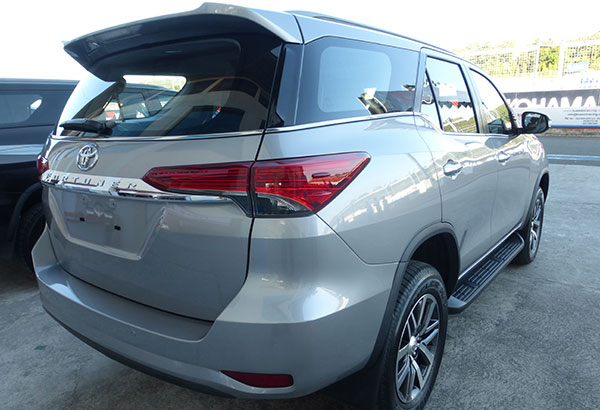The accoutrements of fame and Fortuner
Slightly over a decade following its auspicious debut and fruitful run—surely an understatement—Toyota’s highly popular sports utility vehicle finally gets its much-awaited successor. The second-generation Fortuner made an appearance last month at Toyota Motor Philippines’ (TMP) thanksgiving bash for members of the media. This gave us a tantalizing first-hand glimpse of the all-new Fortuner, validating industry chatter about the ute’s arrival.
Still, seeing the vehicle within the air-conditioned confines of the Marriott Grand Ballroom was admittedly a bit otherworldly. Thing is, while it’s perfectly fine to behold it in suspended animation (read: parked), nothing trumps the tangibility of motion.
So how could I resist when TMP extended a tempting invitation to drive the SUV (along with its two all-new siblings in the Hilux and, hang on, Innova) at the Clark International Speedway, no less? Members of the motoring press had the good, well, fortune to put the vehicles through their paces with guidance from Tuason Racing School’s JP Tuason and his coterie of pros.
Finally, there was sensory confirmation to everything we had heard and seen. New TMP president Satoru Suzuki welcomed the delegation the night before the morning drive. He said that TMP wanted us to get a “360-degree, first-hand experience,” particularly of the Fortuner and Innova, even before their respective launches.
At the ensuing detailed presentations, we were told by Marion Irvin Evangelista of TMP’s sales training section that executive chief engineer Hiroki Nakajima purposefully avoided an “outdated image of a boxy SUV,” and instead focused on “style and (a) cool presence.” Three main unique value propositions highlight the SUV’s new generation: A sleek and distinct design, luxurious and spacious interiors, and more powerful engines. “When you look at the Fortuner compared to its competitors, it’s totally distinct,” he underscored.
The next day, despite an angry sun beating down on our nape and brow, we nonetheless felt blessed to be among the first to log kilometers on the SUV. Recast inside and out, the Fortuner is not a half-hearted attempt at freshness, but an earnest drive at keeping its SUV throne by deserving the honor. Indeed, you neither rest on your laurels nor the volume of past sales. You just move forward.
An all-new GD-series engine motivates the diesel variants, while Toyota’s familiar 2.7-liter gas (now with dual VVT-i) powers the rest. In the driver’s seat of the gas version, I walked through a number of performance tests for the SUV. First was for the Anti-lock Braking System (ABS), which basically keeps the vehicle from skidding even under intense braking. After accelerating to 80 kph, I was asked to step on the brake pedal suddenly and firmly. The Fortuner quickly and confidently stopped and kept a straight face while doing it. The ABS engaged – the pulsating felt through the pedal. Past curves and turns, Toyota’s winning SUV proved easy to steer as it hugged the pavement with minimum roll. We were also able to see for ourselves the very tight turning radius via a roundabout exercise, and a parking drill which highlighted the ease of maneuverability. A Drive Mode Select feature common in all grades also bestows drivers with the choice between fuel-conscious or more vigorous driving.
Later, we hopped aboard the alpha-dog 4x4 diesel variant for a demonstration of its off-roading prowess – helped along by Hill Start Assist and Hill Descent Assist.
On tap for the gas variant are 163 horses (at 5,200 rpm) and 245Nm (at 4,000 rpm) of grunt. Two diesel displacements are available specifically for the 4x4 and 4x2 flavors. The 4x4 gets a 2.8-liter engine promising 174hp (at 3,400 rpm) and 450Nm (from 1,600 to 2,400 rpm); the 4x2 is bestowed a 2.4-liter power plant good for 147hp and 400Nm (at similar rpm).
Longer by 90 mm (at 4,795 mm) and wider by 15 mm (at 1,855 mm) than its outgoing sibling, a shorter height (by 15 mm at 1,835 mm), imbues the Fortuner a sportier profile. The G grade has 17-inch alloy wheels; the more premium V gets 18 inches.
Even as Toyota is still working out the final appointments of the various grades, you can safely expect a standard fin-type radio antenna across all models, a darkened D pillar to give impression of a floating roof (when windows are tinted), and distinct chamois interiors for the G and hazel-brown for the V. There’s more than token space for the second- and third-row occupants, and (count ‘em) 12 cup holders are in the premises for added convenience. Stowing the third-row seats is easier through E-pillar latching points. The top-grade V (4x4) boasts front, driver knee, side, and curtain shield airbags. V variants also get a push-start system and smart keyless entry feature.
With plenty of welcome changes and appointments aplenty, there’s more reason to choose a Fortuner today than ever before.
You can now make your reservation for the SUV, which hits showrooms in March. Its pricing as follows: 2.4 G Diesel M/T (4x2): P1.386 million; 2.7 G Gas A/T (4x2): P1.392 million; 2.4 G Diesel A/T (4x2): P1.476 million; 2.4 V Diesel A/T (4x2): P1.736 million; 2.4 V Diesel A/T (4x2) White Pearl: P1.751 million; 2.8 V Diesel A/T (4x4): P2.126 million; and 2.8 V Diesel A/T (4x4) White Pearl: P2.141 million.
- Latest
















